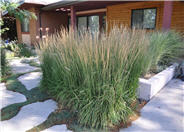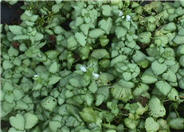
Common name:English Boxwood
Botanical name:Buxus sempervirens
This group of boxwood is comprised of many cultivars that vary in size and somewhat in form. Those most commonly available here in clude 'Grahm Blandy' (columnar to 8 feet), 'Suffruticosa' (rounded form to 3 feet), and 'Inglis' (pyramidal to 7 feet). All are evergreen, with medium to dark green foliage and are generally very cold hardy.

Common name:Karl Foerster Feather Reed Grass
Botanical name:Calamagrostis acutiflora 'Karl Foerster'
Karl Foerster feather reed grass is a garden favorite, and for good reason. Its green, fine-textured foliage is gently arching and grows to about 2 feet tall and wide. Oat-like plumes stand very erect over the foliage, growing as tall as 5 to 6 feet. Plumes open whiteish green, later turning a dusky rose, and then tawny colored by winter. Blooms early summer with the plumes lasting into autumn. Holds its presence well into winter. Excellent in mixed perennial or shrub borders, or massed.

Common name:Dead Nettle
Botanical name:Lamium maculatum
Spotted dead nettle is a moderate to fast growing, herbaceous perennial that forms a low, dense ground cover, usually under 6 inches, with a spread of 18 inches or more. Foliage color is silver-white with green margins, though many cultivars exist, with a seemingly infinite variety in leave color. Flower color is white, pink, rose, or lilac, depending on cultivar. Blooms typically appear late spring to early summer. Use as a ground cover in shrub or foundation borders, under trees, in containers or hanging baskets (though in this later use plants may not over winter).

Common name:European Grapevine
Botanical name:Vitis vinifera
Grapes are a wonderful addition to a garden, even without the fabulous fruit. Grapes are fast growing, and given a proper structure to scramble on, will provide screening and shade. Many species are available that grow along the Wasatch Front, even wine varieties. A very woody, twining, tendrilling vine, they need substantial support. Fruit generally begins to ripen late summer to early fall, depending on the variety. Young leaves can be pickled. Some have lovely fall color. Grows 15 to 25 feet tall and wide.
| Designer: Kelly Pack | Kelly Asian 5 |
Photographer: GardenSoft |
Water Saving Tip:
Apply a layer of mulch around plants to reduce moisture loss.
Choose organic mulches, such as shredded bark, compost or aged sawdust.
